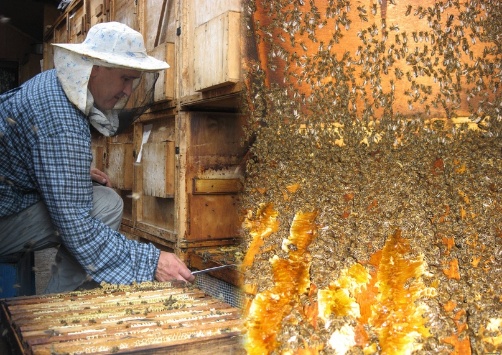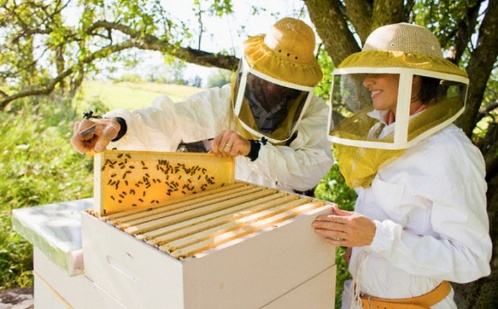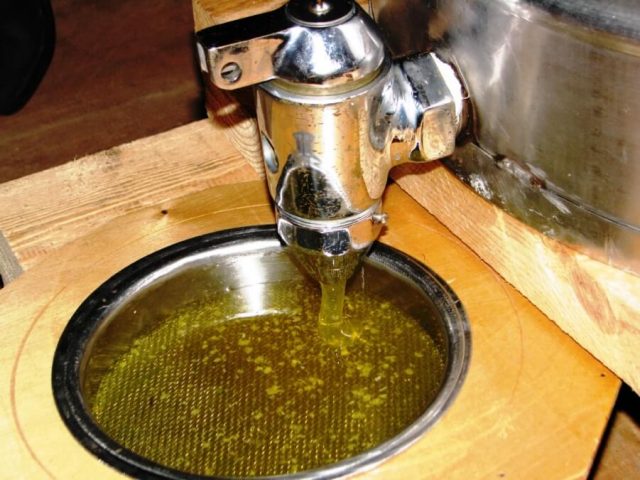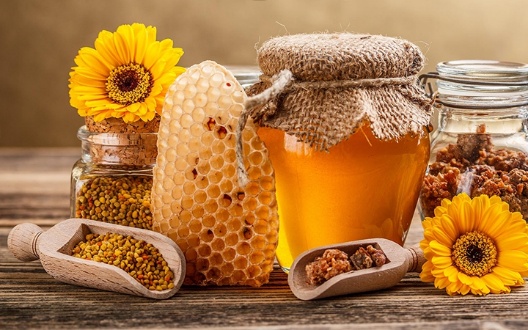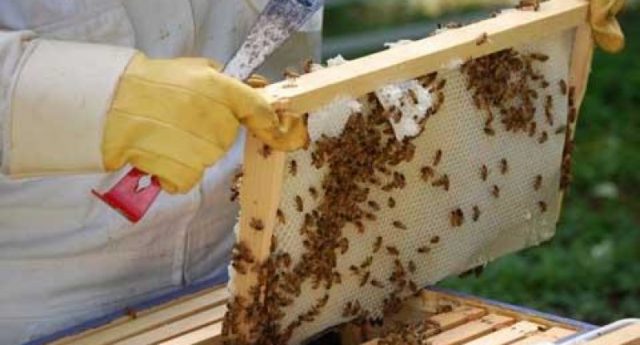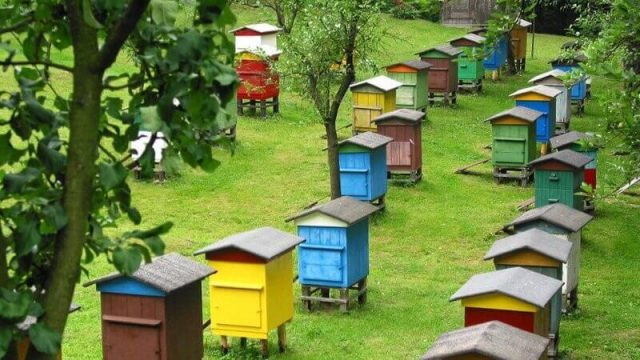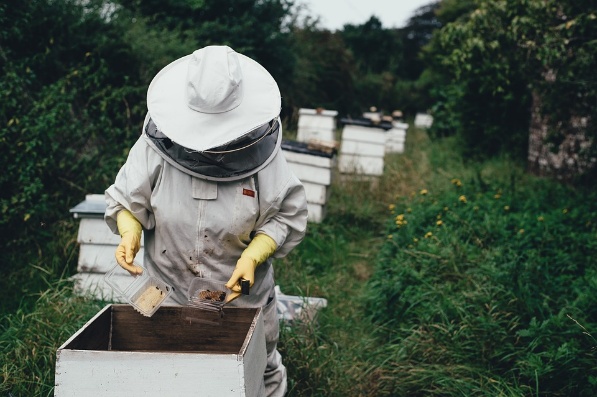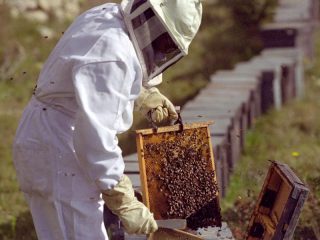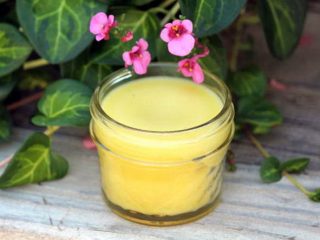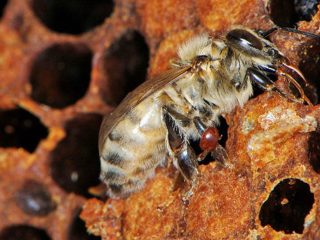Content
- 1 Apiary profitability: is it worth starting
- 2 Step by step bee farming business plan
- 3 Ready-made beekeeping business plan
- 4 Assessment of possible risks
- 5 Conclusion
A business plan for an apiary is drawn up before buying the necessary equipment. Beekeeping is a business like any other and is subject to the same economic laws. In the absence of the necessary funds for an apiary, a business plan will come in handy for obtaining a loan from a bank.
Apiary profitability: is it worth starting
The market in Russia is not even saturated with bee products yet. This niche is still more than half free. The visible abundance of honey is provided by imported beekeeping products. This is usually Chinese honey. It is cheap, but of very poor quality. The Russian beekeeper will have to compete with this product at the expense of quality.
The profitability of the apiary will be high if it is taken seriously. It is still impossible to automate business processes in beekeeping. This is monotonous manual labor. But he also brings good income, if you are not lazy.
An apiary business can bring up to 4 million rubles annually. But this is the amount from which all expenses will have to be deducted. You will also have to do retail on your own. When handing over beekeeping products to dealers, the income from the apiary must be immediately divided by 2 or more.
Step by step bee farming business plan
In fact, a business plan is not a “what to do if I want to start beekeeping” guide. Business plan - calculations, thanks to which you can see in advance whether a particular type of activity will be beneficial. A business plan is drawn up before starting any business. At the same time, the sales market is investigated and the business plan is no longer abstract, but linked to a specific place, as well as time and demand.
In beekeeping, market prices are first looked at. After that, a novice beekeeper needs to evaluate his site: is it suitable for an apiary. If your own plot is not suitable for an apiary, you need to find and rent a suitable one.
Before renting, it is necessary to decide which type of economic activity to choose and register the appropriate company. After registration and clarification of the situation with the site, they build an apiary. Equipment and inventory are bought for her. After that, you can already buy bee colonies and closely engage in beekeeping.
Registration and taxation
You can do beekeeping and not pay taxes, but you have to forget about the nomadic apiary. A stationary apiary will significantly reduce income for almost the same amount of work. In this case, LPH is registered.
Law of 07.07.2003 No. 112-FZ "On personal subsidiary plots" and paragraph 13 of Article 217 of Chapter 23 of the Tax Code of the Russian Federation allow the maintenance of an apiary by individuals on their own plot, provided:
- lack of hired labor in the apiary;
- availability of documents for the apiary;
- if the apiary does not go beyond the boundaries of the site.
Standard for a personal plot: 50 acres. The maximum size to which it can be increased is 250 acres.
Theoretically, even 50 acres should be enough for an apiary for 150 hives and the necessary buildings. Considering that the business plan envisages an apiary for 50 beehives, the minimum size is sufficient and there is no need to pay taxes.But this will impose other restrictions: beekeeping products cannot be sold on the market on their own.
If things go well, and there is a desire to increase the apiary or sell beekeeping products on their own, it makes sense to arrange individual entrepreneurship.
Sole proprietor: why is it needed
This legal status already provides for the payment of taxes. In the case of selling honey through your own retail outlet, when registering an individual entrepreneur, it is better to choose a single tax on imputed income. The amount of this tax depends on the area of the outlet. The fee is fixed and there is no need for a cash register. With this form of business, it is better to choose the OKVED code 52.27.39.
If self-sale of bee products is not planned, it is better to choose another code - 01.25.1, which means that the business will be bee breeding. In this case, you can choose one of two types of taxation: Unified agricultural tax or STS income. In the first case, you will need to pay 6% of the profit. But this is inconvenient for a private beekeeper, who often buys the necessary materials without a receipt. STS income is simpler from the point of view of accounting: 6% of income. And there is no need for full-fledged accounting with debit and credit.
Land lease
The most uncertain moment that cannot be calculated in a business plan. It all depends on the diplomatic skills of the businessman and the greed of the owner of the site. In theory, agricultural firms should only be glad that their fields will be pollinated by bees and provide plots for apiaries free of charge. And sometimes pay extra if the plants themselves are not pollinated. In fact: how will it be possible to agree. From free apiary placement to high rent.
Equipment and inventory
In addition to the obvious: hives and honey extractors, the apiary also needs other equipment, which beginners think a little about. But this obligatory "little thing" must be taken into account when drawing up a business plan:
- beekeeper costume;
- spare frames for hives;
- smoker;
- grate or glass for combustible material in the smoke;
- comb knife;
- mattress catcher;
- box for carrying frames;
- a pollen trap if there are plans to sell pollen;
- beekeeping chisel
- propolis collector;
- stand for storing printed frames;
- honey filter;
- dividing grid for the beehive;
- transportation for bees;
- the trough is inside the hive;
- brushes for cleaning hives.
- other inventory.
You may also need a gas burner and cylinders for it, an elektronavashchivatel or a roller for naschivat, some other, at first glance, non-obvious things.
Apiary equipment is usually inexpensive, within 1000 rubles. But all together when writing a business plan, you can safely put off 20,000 or more. Of the above, the most expensive are: a stand for honey frames and a carrier for bees.
The honeycomb table is expensive. Its price is 8-10 thousand. But this device can perfectly replace a baby bath or a regular basin.
Hives and honey extractor
The cost of hives complete with frames today is 4000-6000. The second major purchase will be the honey extractor, with an average price of 20,000.
Acquisition of bee families
Colonies are best purchased in nurseries where purebred bees are bred. When planning the purchase of a colony of bees in a business plan, one should take into account what is usually sold by young small families. Such colonies in the first season will not give profit. But their cost is also low - 2,000 rubles.
Large strong colonies are usually not available for sale. Unless someone liquidates their apiary. It is more profitable to use a strong family for the production of honey or for obtaining cuttings for sale.
Service staff
Let the apiary be a rather difficult task with completely manual labor, but it is not profitable to hire an employee for 50 hives. The hottest time in the apiary, when it is better not to waste days, is early spring and autumn. In the spring, the colony must be put into operation as soon as possible, every day is expensive here. Autumn is less stressful.After pumping out the honey, all the work in the apiary can be done gradually.
In summer, it is often not recommended to disturb the bees, and 1 person can manage an apiary even for 100 colonies. The hives are inspected every 2 weeks. 10 hives a day - 10 days for inspection, 4 for rest. The grass in the apiary should be mowed as needed, and not every day.
Hiring people is not profitable not only because of taxes, but also because of the salary. In case of formal employment, the amount offered to the employee must be multiplied by 2. The second half of the “wages fund” will go towards the employee's social security payments.
For an apiary of 50 hives, hired employees are not required at all. In the spring, you can ask for help from family members.
Sales of products
In order not to pay taxes and not waste time, honey can be handed over to dealers. But if now the retail price of honey is at least 300 rubles. per kg, then it is more expensive for dealers to hand it over than for 150 rubles. will fail. Even in a very prosperous year, the revenue from 50 hives in this case will be: 50x40x150 = 300,000.
If you have your own place, honey can be sold at a higher price. With a revenue of 600,000 rubles. you will need to pay 6% of the tax. That is, 36,000 rubles. There will be 564,000 rubles left on hand.
Possibility of additional earnings
Even with the sale of honey by hand, the income from an apiary for 50 beehives will be small: about 47,000 rubles. per month. If the beekeeper is lonely, this may be enough for him to live and maintain a business, but the family will demand more. Therefore, it is worth considering the sources of additional income from beekeeping in the business plan. It can be:
- by-products;
- apitherapy;
- provision of services for pollination of greenhouses;
- sale of queens and bee colonies.
The last three are unlikely to turn out to be truly profitable. It makes no sense to take them into account in the business plan.
Sale of other beekeeping products
By-products of beekeeping are understood as:
- pergu;
- wax;
- royal jelly;
- drone homogenate;
- propolis;
- podmore.
Among the by-products of beekeeping, beekeeping is the most profitable. She also has the largest exit from the hive. The retail price of bee bread is 4000 rubles / kg. Although today on the Internet you can find bee bread on sale for 2,000 rubles. The average yield of this product from a hive is 15 kg.
It is not difficult to get this beekeeping product, it is easy to store, and it brings income even more than honey.
The collection of royal jelly is carried out under the strict control of the sanitary services. Labor costs are high here, but the revenue is small. It is easier to collect for immediate consumption than to sell.
Drone homogenate, or milk, is generally not recognized by official medicine. You will have to search for sales routes independently and illegally. It is very difficult to store it, although obtaining it is very simple even without a press: thoroughly knead the combs with 7-day-old drone larvae and strain the resulting liquid.
Likewise, tinctures from podmore are not recognized. But these are alcohol-containing liquids that are easy to store. And you also need to look for buyers yourself.
Propolis yield from an apiary for 50 beehives is about 2 kg. It will be more profitable to sell tinctures at once, since the price of raw materials is also low.
In a business plan for an apiary, both types of tinctures should not be indicated. For the state, this is the illegal sale of alcohol.
The yield of wax from the hive is only 1.5 kg. And a significant part of this beekeeping product is needed by the beekeeper himself for the next year. Only wax and caps contaminated with pathogens are on sale.
These are the "caps" with which the bees seal the honeycomb. It differs in composition from other waxes.
Apitherapy
It should be noted right away that there is no specialty "apitherapist" in the Russian register. On the one hand, this is good for a potential healer. The lack of a profession means that you can practice apitherapy without obtaining a license and medical education.
On the other hand, such illegal activity will be possible until the first allergy sufferer dies of anaphylactic shock.
Pollination earnings
There are many garden and horticultural crops that can only be pollinated by bees. Without such pollination, the plants will not produce crops. Because of this feature, they cannot be grown in greenhouses, since bees fly into these glass structures from the street very reluctantly.
If there is a greenhouse facility nearby, you can rent out hives to it. A hive standing in a greenhouse will help "kill two birds with one stone": pollinate plants and get honey and bee bread.
But the income here cannot be calculated in the same way as with the lease of a land plot. Perhaps there will be just a mutually beneficial cooperation: the beekeeper puts hives in greenhouses for free, the farm receives pollinators for free.
Growing and selling queens and bee colonies
It will be possible to do this business in the apiary only after its own colonies grow. He will not give a big profit. Even if each family swarms annually, 50 families can be obtained from the apiary for sale. At a cost of 2,000 rubles. total annual revenue will be 100,000 rubles. But families do not swarm every year.
Raising queens is even less profitable if the beekeeping business plan was calculated for a honey apiary. You can get a small amount by selling the surplus queens.
Production and sale of beehives and implements
This is a separate type of activity, which should be considered as your own business plan. The profit from the production of hives and inventory depends on the cost of materials for their manufacture, labor costs and the demand for the product. This area has nothing to do with the beekeeping business plan. This can be done without owning an apiary.
Ready-made beekeeping business plan
For a budding entrepreneur, selling honey to dealers means killing the business in the bud. It is worth trying to calculate a business plan immediately with the sale of honey at your own retail outlet. Initial costs for a 50 hive apiary:
- hives 60 pcs. 5,000-300,000 rubles each;
- bee colonies 50 pieces, 2,000-100,000 rubles each;
- honey extractor - 20,000 rubles;
- table for honeycombs - 9,000 rubles;
- spare frames for beehives 100 pcs. - 10,000 rubles;
- veterinary drugs - 10,000 rubles;
- inventory - 20,000 rubles;
- paperwork and rent of a trading place - 50,000 rubles;
- unforeseen expenses - 100,000 rubles;
- means for living for 2 years - 480,000 rubles;
Total amount: 1.099 million rubles.
You should not take it close to each other. There are always some circumstances that require additional funds. The bank needs to ask for a loan of 1.5 million rubles.
In the first year, it is hardly possible to get income from the apiary, since the families will still be weak, and all the honey must be left to them. 40 kg per hive is the maximum possible figure. Most likely, you will get less honey. The average amount of bee bread per hive is 15 kg. The main income in beekeeping comes from the sale of these two products. Selling beekeeping products on your own through your own retail outlet will give you twice the income:
- honey of 30 kg from 50 families at a cost of 300 rubles / kg - 450,000 rubles;
- bee bread 15 kg from 50 beehives at a cost of 2,000 rubles / kg - 1.5 million
Total income: 1.95 million rubles. for the second year.
From income you will need to pay 6% tax: 117,000 rubles. Net income: 1.833 million rubles
Theoretically, it is already possible to fully repay the loan. Net income is not profit yet. This money will need to purchase consumables for the next year. The apiary will fully pay off and start working in the third year.
It is unlikely that the sale of wax and propolis will cover even the overhead costs.
List of documents required to start
It is very difficult to say whether documents are needed to open an apiary, as it depends on the path that will be chosen for the development of beekeeping. A dozen beehives in your own garden - a subsidiary farm, for which registration is not required.But such a number of colonies is really only for their own consumption and a little sale to friends. Actually, the lack of sale of beekeeping products is the reason for not registering the apiary.
If you immediately start a serious business, papers for the apiary will be needed:
- documents confirming ownership of land or land lease;
- veterinary passport of the apiary indicating the location and all the necessary veterinary and sanitary measures;
- a certificate with the analysis of honey, which, among other things, indicates the data of the owner of the apiary;
- a veterinary certificate giving the right to sell beekeeping products;
- a certificate of the number of colonies in the apiary issued by the local veterinary service.
As a safety net, you can also take information about the presence of heavy metals in honey, analysis of bee brood and podmor. But these certificates are optional, although desirable.
The rest of the documents are standard for starting any business. For apiary practice, it used to be better to arrange a private household plots. After the release of the law on self-employed, it may be better to formalize this way.
Be sure to ask the local authorities if the new apiary will interfere with the existing ones. It is also necessary to find out where the bees cannot be taken if the apiary is nomadic.
Assessment of possible risks
With external benefits, beekeeping is a risky business. When calculating a business plan, you need to take into account that the apiary can all die from the varroa mite, nosematosis or European foulbrood.
Often the owner himself causes the death of the apiary due to an incorrect assessment of the upcoming winter. Families can freeze out in severe frost. In the hot summer, the apiary placed in the sun will all die from the heat. But these are disposable moments.
Today, beekeeping is also difficult due to climate change and the unexplained extinction of bees in the world. But in a business plan, this is difficult to take into account due to the unpredictability of the phenomenon.
Conclusion
A business plan for an apiary is necessary not only to convince the bank of the profitability of a loan, but also to find out for yourself whether it is worth doing beekeeping. The business plan is first calculated in rough terms for themselves and only then they decide whether it is necessary to engage in beekeeping. But it is optimal to work on someone else's apiary for a couple of years to gain experience.
